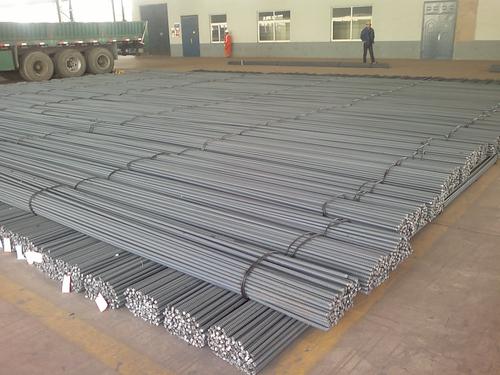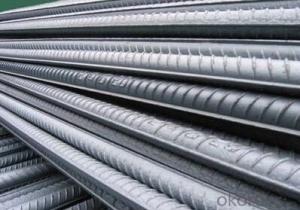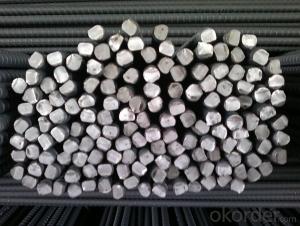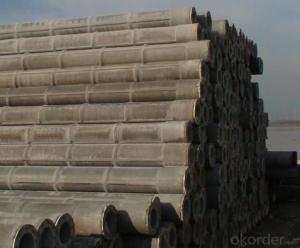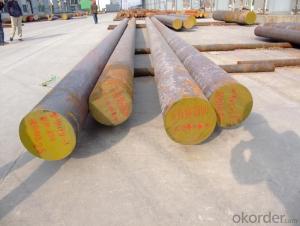Alloy Hot Rolled Deformed Steel Rebars for Construction of Buildings
- Loading Port:
- Tianjin
- Payment Terms:
- TT or LC
- Min Order Qty:
- 25 m.t.
- Supply Capability:
- 100000 m.t./month
OKorder Service Pledge
OKorder Financial Service
You Might Also Like
Product Description:
OKorder is offering Alloy Hot Rolled Deformed Steel Rebars for Construction of Buildings at great prices with worldwide shipping. Our supplier is a world-class manufacturer of steel, with our products utilized the world over. OKorder annually supplies products to European, North American and Asian markets. We provide quotations within 24 hours of receiving an inquiry and guarantee competitive prices.
Product Applications:
Alloy Hot Rolled Deformed Steel Rebars for Construction of Buildings are ideal for structural applications and are widely used in the construction of buildings and bridges, and the manufacturing, petrochemical, and transportation industries.
Product Advantages:
OKorder's Alloy Hot Rolled Deformed Steel Rebars for Construction of Buildings are durable, strong, and resist corrosion. They are made of high quality material.
Main Product Features:
· Premium quality
· Prompt delivery & seaworthy packing (30 days after receiving deposit)
· Corrosion resistance
· Can be recycled and reused
· Mill test certification
· Professional Service
· Competitive pricing
Product Specifications:
Specifications of HRB500 Deformed Steel Bar:
Standard | GB | HRB500 |
Diameter | 6mm,8mm,10mm,12mm,14mm,16mm,18mm,20mm, 22mm,25mm,28mm,32mm,36mm,40mm,50mm | |
Length | 6M, 9M,12M or as required | |
Payment term | TT or L/C | |
Application | mainly used in construction industry to reinforce concrete structures and so on | |
Quality | First quality, the goods are from Chinese big manufacturers. | |
Type | Hot rolled deformed steel bar | |
Brand name | DRAGON | |
Chemical Composition: (Please kindly find our chemistry of our material based on HRB500 as below for your information)
Grade | Technical data of the original chemical composition (%) | ||||||
C | Mn | Si | S | P | V | ||
HRB500 | ≤0.25 | ≤1.60 | ≤0.80 | ≤0.045 | ≤0.045 | 0.08-0.12 | |
Physical capability | |||||||
Yield Strength (N/cm²) | Tensile Strength (N/cm²) | Elongation (%) | |||||
≥500 | ≥630 | ≥12 | |||||
Theoretical weight and section area of each diameter as below for your information:
Diameter(mm) | Section area (mm²) | Mass(kg/m) | Weight of 12m bar(kg) |
6 | 28.27 | 0.222 | 2.664 |
8 | 50.27 | 0.395 | 4.74 |
10 | 78.54 | 0.617 | 7.404 |
12 | 113.1 | 0.888 | 10.656 |
14 | 153.9 | 1.21 | 14.52 |
16 | 201.1 | 1.58 | 18.96 |
18 | 254.5 | 2.00 | 24 |
20 | 314.2 | 2.47 | 29.64 |
22 | 380.1 | 2.98 | 35.76 |
25 | 490.9 | 3.85 | 46.2 |
28 | 615.8 | 4.83 | 57.96 |
32 | 804.2 | 6.31 | 75.72 |
36 | 1018 | 7.99 | 98.88 |
40 | 1257 | 9.87 | 118.44 |
50 | 1964 | 15.42 | 185.04 |
Usage and Applications of Alloy Hot Rolled Deformed Steel Rebars for Construction of Buildings:
Deformed bar is widely used in buildings, bridges, roads and other engineering construction. Big to highways, railways, bridges, culverts, tunnels, public facilities such as flood control, dam, small to housing construction, beam, column, wall and the foundation of the plate, deformed bar is an integral structure material. With the development of world economy and the vigorous development of infrastructure construction, real estate, the demand for deformed bar will be larger and larger..
Packaging & Delivery of Alloy Hot Rolled Deformed Steel Rebars for Construction of Buildings:
Packaging Detail: products are packed in bundle and then shipped by container or bulk vessel, deformed bar is usually naked strapping delivery, when storing, please pay attention to moisture proof. The performance of rust will produce adverse effect.
Each bundle weight: 2-3MT, or as required
Delivery Detail: within 45 days after received advanced payment or LC.
Label: to be specified by customer, generally, each bundle has 1-2 labels
Trade terms: FOB, CFR, CIF
FAQ:
Q1: How do we guarantee the quality of our products?
A1: We have established an advanced quality management system which conducts strict quality tests at every step, from raw materials to the final product. At the same time, we provide extensive follow-up service assurances as required.
Q2: How soon can we receive the product after purchase?
A2: Within three days of placing an order, we will begin production. The specific shipping date is dependent upon international and government factors, but is typically 7 to 10 workdays.
Q3: Can stainless steel rust?
A3: Stainless does not "rust" as you think of regular steel rusting with a red oxide on the surface that flakes off. If you see red rust it is probably due to some iron particles that have contaminated the surface of the stainless steel and it is these iron particles that are rusting. Look at the source of the rusting and see if you can remove it from the surface.
Images:
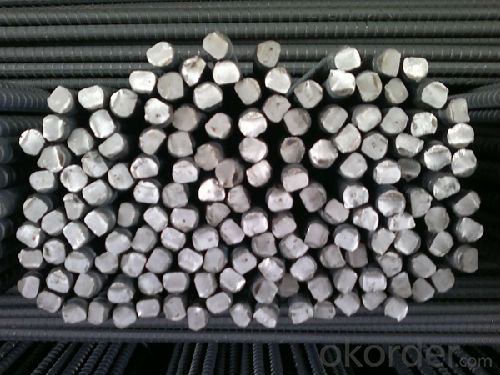

- Q: How is steel wire rod used in the manufacturing of wire for aerospace applications?
- Steel wire rod is a crucial component in the manufacturing of wire for aerospace applications. The wire rod serves as the primary raw material for producing high-quality wires that are specifically designed to meet the demanding requirements of the aerospace industry. Firstly, the steel wire rod undergoes a series of processes such as cleaning, descaling, and heat treatment to enhance its mechanical properties and ensure its purity. These processes help in removing any impurities or contaminants that may affect the wire's performance or structural integrity. Once the steel wire rod is prepared, it is then drawn through a series of dies to reduce its diameter and increase its length. This drawing process is performed multiple times to achieve the desired wire thickness and strength. The wire is carefully monitored during this process to maintain its dimensional accuracy and ensure consistent quality. After the wire has been drawn to the required size, it undergoes further treatments such as annealing or stress relieving to improve its ductility and resistance to fatigue. These treatments are essential in aerospace applications where the wire will be subjected to extreme forces and temperature variations. The manufactured wire is then subjected to rigorous testing and quality control measures to ensure it meets the stringent standards set by the aerospace industry. These tests include checking the wire's mechanical properties, surface finish, and dimensional accuracy. Once the wire passes all the necessary tests, it is ready to be used in various aerospace applications. Steel wire manufactured from wire rod is commonly used in aircraft control cables, wiring harnesses, fasteners, springs, and other critical components. The wire's high strength, durability, and resistance to corrosion make it suitable for withstanding the demanding conditions of aerospace environments. In summary, steel wire rod plays a vital role in the manufacturing of wire for aerospace applications. It undergoes various processes to enhance its properties, undergoes drawing and treatment processes to achieve the desired wire dimensions and strength, and is thoroughly tested to ensure it meets aerospace standards. The resulting wire is then used in critical aerospace components, contributing to the overall safety and performance of aerospace systems.
- Q: How is steel wire rod used in the production of wire mesh for sieving?
- Steel wire rod is a crucial component in the production of wire mesh for sieving. The wire rod is first processed through a series of manufacturing steps to transform it into a suitable material for wire mesh production. This includes drawing the rod through a die to reduce its diameter and increase its length, resulting in a thin and elongated wire. Once the wire rod has been transformed into wire, it is then woven or welded together to create wire mesh. Wire mesh is a grid-like structure with evenly spaced intersecting wires, forming a pattern of uniform openings. This mesh is designed to efficiently filter and separate particles based on their size. In the production of wire mesh for sieving, the steel wire rod is typically used to create the woven wire mesh. The wire is woven together using various weaving techniques, such as plain weave, twill weave, or Dutch weave, depending on the desired mesh characteristics. The wire rod's properties, such as its strength, flexibility, and resistance to corrosion, play a vital role in the quality and durability of the wire mesh. The wire rod's strength ensures that the wire mesh can withstand the tension and stress it may encounter during sieving operations. Additionally, the flexibility of the wire allows the mesh to be easily shaped and manipulated into various sizes and configurations to meet specific sieving requirements. Furthermore, the steel wire rod's resistance to corrosion prevents the wire mesh from deteriorating when exposed to moisture or harsh environmental conditions. This corrosion resistance is particularly important when wire mesh is used in applications where it comes into contact with liquids or substances that could potentially cause damage. Overall, the steel wire rod is an essential material in the production of wire mesh for sieving. Its transformation into wire and subsequent weaving or welding processes enable the creation of durable, reliable, and efficient wire mesh, which is widely used in various industries for sieving and separating particles of different sizes.
- Q: What are the different surface protection methods for steel wire rod?
- There are several different surface protection methods available for steel wire rods, each offering varying levels of protection and suitability for different applications. Some of the common surface protection methods for steel wire rods include: 1. Galvanization: This method involves applying a layer of zinc coating to the surface of the steel wire rod. Galvanization provides excellent corrosion resistance, protecting the steel from environmental factors such as moisture and chemicals. It is a widely used method, especially for outdoor applications or in corrosive environments. 2. Coating: Steel wire rods can be coated with various materials such as epoxy, PVC, or polyethylene. These coatings provide a barrier between the steel surface and external elements, preventing corrosion and abrasion. Coatings can also enhance the wire's resistance to chemicals, UV radiation, and other damaging factors. 3. Phosphating: Phosphating is a surface treatment method that involves applying a phosphate coating to the steel wire rod. This process creates a thin layer of phosphate crystals on the surface, which improves adhesion for subsequent coatings or paints. Phosphating also provides some level of corrosion resistance. 4. Electroplating: Electroplating involves depositing a thin layer of metal onto the surface of the steel wire rod through an electrochemical process. Common metals used for electroplating include zinc, nickel, and chromium. This method enhances the wire's resistance to corrosion, wear, and tarnishing. Electroplating can also impart aesthetic appeal to the wire, making it suitable for decorative applications. 5. Powder coating: In this method, a dry powder is applied to the steel wire rod electrostatically and then cured under heat. The powder melts and forms a protective coating on the wire's surface. Powder coating offers excellent durability, resistance to corrosion, chemicals, and UV radiation. Additionally, it provides a range of color options and a smooth, attractive finish. It is essential to choose the appropriate surface protection method based on the specific requirements and environment in which the steel wire rod will be used. Factors such as corrosion resistance, abrasion resistance, aesthetics, and cost-effectiveness should be considered when selecting the most suitable method.
- Q: How is steel wire rod used in the manufacturing of wire rope slings for marine applications?
- Steel wire rod is a crucial component in the manufacturing of wire rope slings for marine applications. These slings are extensively used in various marine industries, including shipping, offshore oil and gas, and fishing. To begin with, steel wire rod serves as the raw material for wire rope slings. It is typically made from high-quality carbon or alloy steel, which ensures the strength and durability required for marine applications. The steel wire rod is usually produced in a continuous casting process, resulting in a long, cylindrical shape. Once the steel wire rod is obtained, it undergoes a series of manufacturing processes to transform it into wire rope slings. The first step involves drawing the steel wire rod through a die to reduce its diameter and increase its length. This process is repeated multiple times to achieve the desired wire diameter. The drawn wire is then cleaned to remove any impurities or surface contaminants. Next, the cleaned wire is twisted together to form strands. The number of strands can vary depending on the desired strength and load capacity of the wire rope sling. These strands are then tightly wound around a central core, which provides stability and support to the wire rope. The final step in the manufacturing process is the application of protective coatings to enhance the wire rope sling's resistance to corrosion and wear. Marine environments are highly corrosive due to the presence of saltwater, which can lead to the degradation of steel. Therefore, coatings such as galvanization or zinc plating are commonly applied to the wire rope to provide a barrier against corrosion. Once the steel wire rod has been transformed into a wire rope sling, it is ready for use in various marine applications. Wire rope slings are used for a wide range of purposes, including lifting heavy loads, securing cargo, and towing vessels. They are known for their high strength, flexibility, and resistance to abrasion, making them ideal for demanding marine environments. In conclusion, steel wire rod plays a vital role in the manufacturing of wire rope slings for marine applications. It serves as the raw material for wire rope production, undergoes various manufacturing processes, and is ultimately transformed into a strong and durable sling. Wire rope slings made from steel wire rod are essential tools in the marine industry, providing reliable and safe lifting and securing capabilities.
- Q: How are steel wire rods packaged and shipped?
- To ensure the safety and integrity of steel wire rods during transportation, a specific packaging and shipping process is followed. This process consists of several steps. Firstly, steel wire rods are typically bound together using steel straps or wires. This bundling process ensures that the rods stay aligned and tightly secured, preventing any potential movement or damage while in transit. Furthermore, it helps maintain the shape and structure of the rods. Once bundled, the steel wire rods are loaded onto pallets or wooden skids. These pallets provide a stable base and allow for easy handling with forklifts or cranes. The rods are carefully placed on the pallets, ensuring proper balance to evenly distribute the weight. After being loaded onto pallets, the steel wire rods are often wrapped with stretch film or other protective material. This wrapping not only secures the rods to the pallet but also shields them from moisture, dust, and other environmental factors during transportation. Additionally, to enhance protection, steel wire rods may be packaged in wooden crates or steel frames. These additional packaging options provide an extra layer of security, safeguarding the rods against potential damage during handling and transportation. Once properly packaged, the steel wire rods are ready for shipping. Depending on factors such as destination and volume, they can be transported via trucks, trains, ships, or airplanes. The choice of transportation method is determined by considerations such as distance, cost, and urgency. During shipping, it is crucial to handle the packaged steel wire rods with care. Appropriate equipment should be used for loading and unloading to minimize the risk of damage. Furthermore, the packages must be adequately secured within the transportation vehicle to prevent any movement or shifting during transit. In conclusion, the packaging and shipping of steel wire rods involve bundling, palletizing, wrapping with protective material, and potentially using additional packaging such as crates or frames. The packaged rods are then transported through various means, ensuring proper handling and security to maintain their quality and integrity.
- Q: How is steel wire rod used in the construction of bridges?
- Steel wire rod is commonly used in the construction of bridges as it provides strength, durability, and flexibility. It is primarily used for reinforcing concrete structures, such as bridge decks and foundations, to enhance their load-carrying capacity and structural integrity. Additionally, steel wire rod is also utilized for suspension cables and stay cables in cable-stayed bridges, offering high tensile strength to support the bridge structure efficiently. Overall, steel wire rod plays a crucial role in ensuring the safety and longevity of bridges by reinforcing and providing structural support.
- Q: How are steel wire rods used in the production of screws and bolts for construction projects?
- Steel wire rods are used in the production of screws and bolts for construction projects as they serve as the raw material for manufacturing these fasteners. The wire rods are first heated and then rolled into the desired diameter and length, which are then cut and threaded to form screws and bolts. These high-strength steel wire rods ensure the durability and structural integrity of the fasteners, making them suitable for various construction applications.
- Q: How is steel wire rod used in the manufacturing of wire screens?
- Steel wire rod is used in the manufacturing of wire screens as the primary raw material. It is first drawn through a series of dies to reduce its diameter and increase its length, resulting in a smooth and uniform wire. This wire is then woven or welded together to create wire screens, which are commonly used in various industries for filtration, screening, and protection purposes. The strength and durability of steel wire rod make it particularly suitable for withstanding heavy loads and harsh environments, ensuring the longevity and effectiveness of wire screens.
- Q: What are the main factors influencing the choice of steel wire rod distributor?
- The main factors influencing the choice of a steel wire rod distributor include the distributor's reputation and reliability, the quality and consistency of the wire rod they provide, their pricing and availability, their ability to meet specific requirements and specifications, and their customer service and support. Other factors may include their location and proximity to the buyer, their experience and expertise in the industry, and any additional value-added services they offer.
- Q: What are the different types of steel wire rod coatings used for lubrication?
- There are several different types of steel wire rod coatings used for lubrication, each with its own unique properties and benefits. Some of the most commonly used coatings include: 1. Zinc Coating: Zinc coatings are widely used for lubrication purposes as they provide excellent corrosion resistance. The zinc coating acts as a sacrificial layer, protecting the underlying steel wire rod from rust and other forms of corrosion. Additionally, zinc coatings can also act as a lubricant, reducing friction between the wire rod and other surfaces. 2. Phosphate Coating: Phosphate coatings are often used as pre-treatments before applying other lubricant coatings. These coatings create a layer of phosphate crystals on the wire rod's surface, which enhances the adhesion of subsequent lubricant coatings. Phosphate coatings also improve the wire rod's wear resistance and provide a smooth surface for better lubrication. 3. Polymer Coating: Polymer coatings are commonly used for lubrication purposes due to their excellent friction-reducing properties. These coatings are typically made of synthetic polymers such as polytetrafluoroethylene (PTFE) or polyamide. Polymer coatings create a low-friction surface that reduces wear and tear, increases the lifespan of the wire rod, and improves its performance in various applications. 4. Wax Coating: Wax coatings are another popular choice for lubricating steel wire rods. These coatings are typically made of natural or synthetic waxes and are applied by either dipping or spraying the wire rod. Wax coatings provide a protective layer that reduces friction, prevents rust, and improves the wire rod's handling during manufacturing and processing. 5. Oil Coating: Oil coatings are commonly used for temporary lubrication of steel wire rods during storage and transportation. These coatings are typically applied as a thin layer of oil that provides immediate lubrication and corrosion protection. Oil coatings are easily applied and can be removed easily before further processing or use. It is important to note that the selection of a specific coating depends on various factors, including the desired level of lubrication, corrosion resistance, and the specific application of the wire rod. Manufacturers often consider factors such as cost, performance requirements, and environmental considerations when choosing the appropriate coating for steel wire rods.
Send your message to us
Alloy Hot Rolled Deformed Steel Rebars for Construction of Buildings
- Loading Port:
- Tianjin
- Payment Terms:
- TT or LC
- Min Order Qty:
- 25 m.t.
- Supply Capability:
- 100000 m.t./month
OKorder Service Pledge
OKorder Financial Service
Similar products
Hot products
Hot Searches
Related keywords



